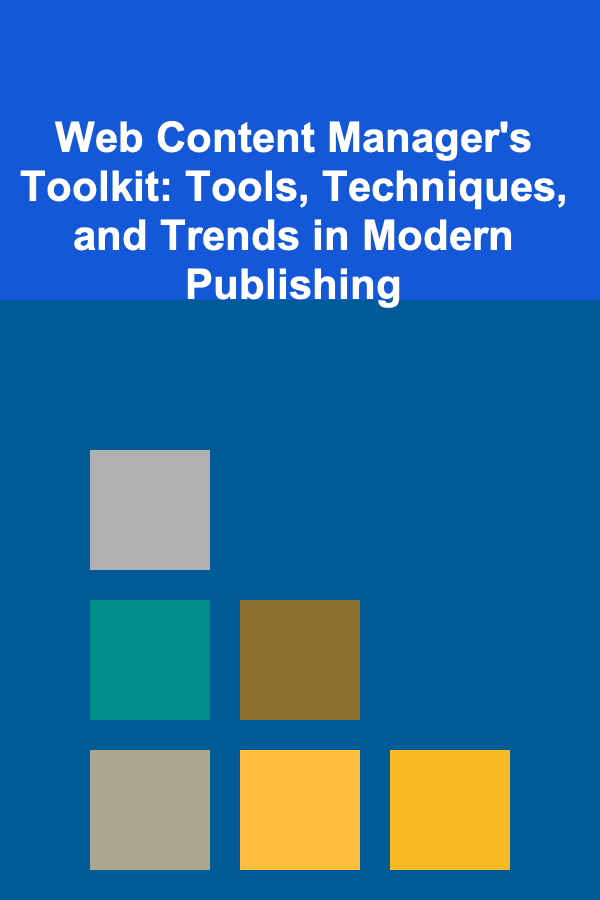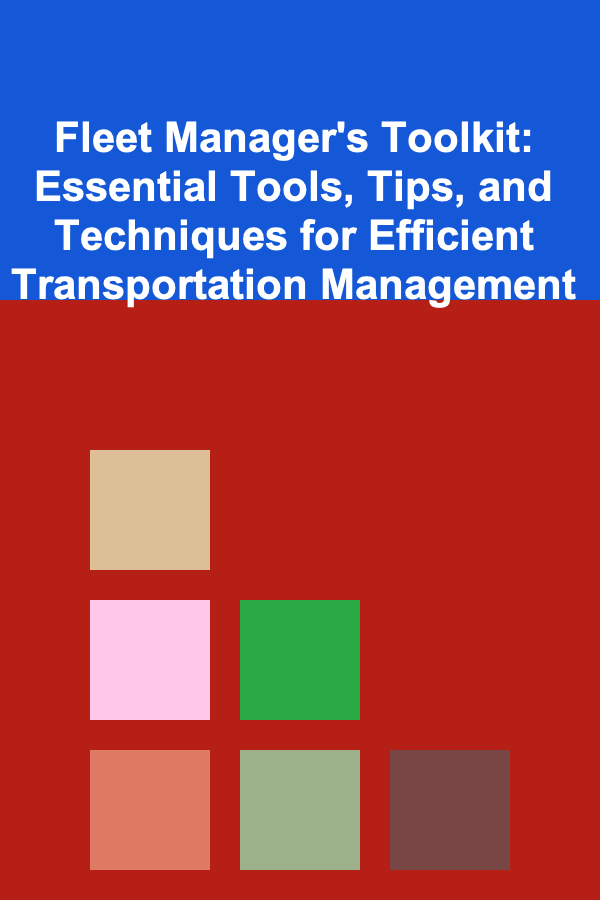
Web Content Manager's Toolkit: Tools, Techniques, and Trends in Modern Publishing
ebook include PDF & Audio bundle (Micro Guide)
$12.99$7.99
Limited Time Offer! Order within the next:

In the fast-evolving world of digital content, web content managers (WCMs) are tasked with a multifaceted role. They not only ensure that content is engaging and informative but also make sure it's optimized for search engines, accessible to users across devices, and strategically aligned with business goals. With the ever-expanding range of tools, techniques, and trends in modern publishing, mastering this field requires both creativity and a strong grasp of digital tools. This actionable guide dives deep into the best practices and strategies for web content managers to thrive in today's digital-first environment.
Essential Tools for Web Content Management
The tools that a web content manager utilizes are crucial to the success of any content strategy. From content creation to optimization, content management systems (CMS), and data analytics, these tools not only streamline workflows but also allow for better decision-making. Let's explore some essential tools:
1. Content Management Systems (CMS)
A good CMS forms the backbone of any content management process. It's the platform that allows you to create, edit, manage, and publish content without having to rely heavily on technical skills.
- WordPress: One of the most widely used CMS platforms, WordPress offers flexibility, scalability, and an extensive library of plugins to extend its functionality. It's ideal for both beginners and advanced users.
- Drupal: Known for its robust security and scalability, Drupal is favored by organizations that require highly customized, large-scale websites. It is perfect for managing complex content workflows.
- Contentful: A headless CMS that allows for seamless integration across various platforms. Its flexibility is great for businesses that want to distribute content through multiple channels like websites, mobile apps, and IoT devices.
2. SEO Tools
SEO is a cornerstone of web content management. Ensuring that your content ranks well on search engines and is discoverable by your target audience is essential.
- Google Analytics: This tool is indispensable for understanding user behavior, traffic sources, and content performance. Use it to track page views, bounce rates, average time on page, and user flow.
- SEMrush: A comprehensive SEO tool that helps with keyword research, on-page SEO, competitor analysis, and backlink tracking. It's essential for any content manager who aims to optimize content for organic search.
- Yoast SEO: A WordPress plugin that helps with on-page SEO. It provides real-time analysis of your content, offering tips for improving readability and keyword usage.
3. Content Collaboration and Workflow Tools
Collaboration tools enable web content managers to work seamlessly with content creators, editors, and other stakeholders, ensuring that content is produced on time and to a high standard.
- Trello: A simple and effective project management tool that helps track tasks and deadlines, especially when managing multiple pieces of content. Its visual layout makes it easy to track the status of each content item.
- Slack: A messaging app that enhances team communication. With integrations for Google Drive, Dropbox, and other tools, Slack helps streamline collaboration and ensures quick feedback on content drafts.
- Asana: This task management tool is ideal for setting timelines, assigning tasks, and ensuring that each step in the content production process is completed on time.
4. Analytics and Performance Tracking
Understanding how well your content is performing is crucial for refining strategies and improving user engagement. These analytics tools provide valuable insights into content effectiveness and user behavior.
- Google Search Console: A free tool that allows you to monitor and maintain your website's presence in Google Search. It helps with analyzing the keywords that bring traffic, indexing issues, and mobile usability.
- Hotjar: A user behavior analytics tool that uses heatmaps and session recordings to show how users interact with your website. This is invaluable for improving UX and optimizing your content for better engagement.
5. Visual Content Tools
Visual content is essential for engaging audiences. It can boost user experience, shareability, and overall engagement. These tools help content managers create, edit, and optimize visual content.
- Canva: An easy-to-use graphic design tool that allows you to create professional-quality graphics, social media posts, and infographics without requiring advanced design skills.
- Adobe Photoshop: While more advanced than Canva, Photoshop offers greater control and customization for image editing. It's perfect for high-quality images and detailed design work.
- Lumen5: A video creation platform that transforms articles into videos, allowing content managers to repurpose written content into engaging visual formats.
Techniques for Effective Web Content Management
The right tools are important, but a web content manager's techniques and strategies are just as critical. Here are some effective techniques to optimize content management and drive success:
1. Content Personalization
One of the most effective ways to engage users is through personalized content. Personalization helps to deliver relevant information based on user behavior, preferences, and demographics. For instance, you could personalize your homepage, product recommendations, or email newsletters based on a user's past actions on your site.
- Dynamic Content: Use dynamic content features in your CMS to deliver tailored content. For example, show specific product recommendations to visitors who've previously viewed similar products or offer a special discount to returning users.
- Behavioral Targeting: Tools like HubSpot and OptinMonster allow you to track user behavior and serve personalized pop-ups, CTAs (Calls-to-Action), or content based on this data.
2. SEO Optimization
Ensuring that your content is optimized for search engines is non-negotiable in today's competitive digital space. It not only helps increase visibility but also enhances user experience by providing valuable, relevant content.
- Keyword Research: Use tools like SEMrush and Google Keyword Planner to identify relevant keywords for your niche. Integrate these keywords naturally into your content to improve SEO rankings.
- On-Page SEO: Optimize title tags, meta descriptions, headers, and internal linking. Incorporate relevant keywords and maintain a clear structure to enhance readability and searchability.
- Mobile Optimization: With an increasing number of users browsing content on mobile devices, ensuring that your content is mobile-friendly is crucial. Use responsive design and check mobile performance regularly with tools like Google Mobile-Friendly Test.
3. Content Diversification
The content landscape is increasingly diverse. Relying solely on one content format can limit your reach and engagement. Diversifying the type of content you produce is essential for catering to different audience preferences and boosting overall user engagement.
- Blog Posts: In-depth articles, how-to guides, and case studies are still the cornerstone of web content. Ensure that your blog posts provide valuable insights and address user pain points.
- Videos and Webinars: Visual content like videos, tutorials, and webinars can help break down complex topics, engage users, and improve retention rates.
- Infographics: Infographics simplify complex information and are highly shareable on social media. Tools like Canva or Visme can help create engaging infographics.
- User-Generated Content: Encourage users to share their experiences, reviews, and testimonials. This not only adds authenticity but also increases social proof and trust in your brand.
4. Content Automation
In modern content management, automation is key to improving efficiency and ensuring timely delivery of content. Automating repetitive tasks can free up time for more strategic work.
- Social Media Scheduling: Tools like Buffer and Hootsuite allow you to schedule and automate social media posts, ensuring consistent content distribution without manual intervention.
- Email Marketing Automation: Platforms like Mailchimp and ConvertKit allow you to automate email campaigns, segment audiences, and personalize content based on user behavior.
- Content Curation: Tools like Feedly and Pocket help in discovering and curating content from trusted sources. You can automate sharing this curated content to your audience through social channels or email newsletters.
5. Continuous Testing and Optimization
Web content managers must adopt a data-driven approach to constantly optimize content for better performance. Regular testing and optimization help ensure that content is always aligned with user needs and business goals.
- A/B Testing: Use tools like Google Optimize and Unbounce to conduct A/B tests on your content, including headlines, CTAs, and landing pages. This helps determine which variations resonate best with your audience.
- Conversion Rate Optimization (CRO): Use tools like Optimizely and VWO to test different variations of your website and content, aiming to improve conversion rates and lead generation.
- Performance Monitoring: Regularly review content performance metrics using tools like Google Analytics and Hotjar to understand what's working and what isn't. Refine your content strategy based on these insights.
Trends in Modern Publishing
The digital publishing world is constantly evolving, with new technologies, trends, and user behaviors influencing content management practices. Here are some key trends shaping modern publishing:
1. Voice Search Optimization
With the rise of voice-activated assistants like Siri, Alexa, and Google Assistant, voice search is becoming increasingly important. Optimizing content for voice search requires a focus on natural language, long-tail keywords, and question-based queries.
2. Artificial Intelligence and Machine Learning
AI and machine learning are revolutionizing content personalization and optimization. AI-powered tools can analyze user behavior, predict content preferences, and serve personalized recommendations in real time. These technologies are also being used to automate content creation, especially for simple, data-driven pieces like reports or news updates.
3. Interactive Content
Interactive content is gaining popularity because it encourages user participation and increases engagement. Quizzes, polls, calculators, and interactive infographics not only entertain users but also provide valuable data that can help further optimize content.
4. Video-First Content
Video consumption is at an all-time high, and video content continues to dominate the digital landscape. Live streaming, video tutorials, explainer videos, and webinars are essential components of a modern content strategy. Platforms like YouTube, TikTok, and Instagram are pushing the boundaries of video-first content strategies.
5. User Privacy and Data Protection
As concerns about data privacy continue to rise, content managers need to prioritize user consent and data protection. Ensuring compliance with regulations like GDPR and CCPA is essential, and transparent data collection practices are critical to maintaining user trust.
Conclusion
Modern web content management is a dynamic and challenging field, but with the right toolkit, techniques, and an understanding of emerging trends, content managers can lead their teams to success. By focusing on user-centered strategies, adopting automation tools, optimizing content for SEO, and staying current with new publishing trends, web content managers can ensure that their content remains engaging, relevant, and effective in driving business objectives.

Fleet Manager's Toolkit: Essential Tools, Tips, and Techniques for Efficient Transportation Management
Read More
How to Curate a Meaningful Decor Collection
Read More
How to Develop a Mindful Approach to Exercise
Read More
How to Explore Nature with Family Hiking Adventures
Read More
How to Organize Your Cleaning Supplies Efficiently
Read More
How to Sell Travel-Related Products and Merchandise: A Comprehensive Guide
Read MoreOther Products

Fleet Manager's Toolkit: Essential Tools, Tips, and Techniques for Efficient Transportation Management
Read More
How to Curate a Meaningful Decor Collection
Read More
How to Develop a Mindful Approach to Exercise
Read More
How to Explore Nature with Family Hiking Adventures
Read More
How to Organize Your Cleaning Supplies Efficiently
Read More